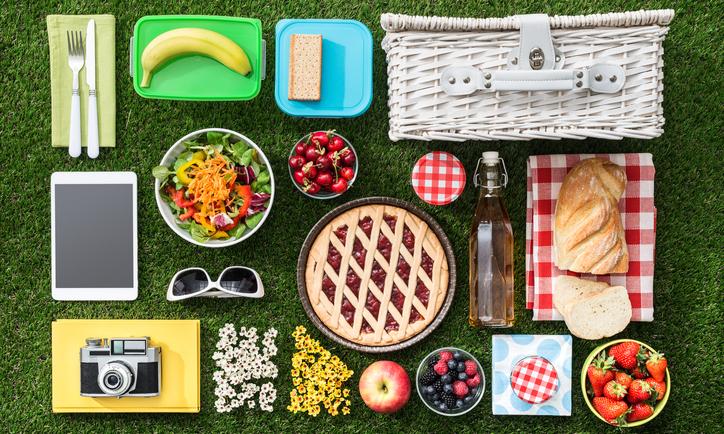Food Safety
Be sure to plan, portion, and pack your meal with food safety in mind for a worry-free trip.
- Pack smart: Put the popular items, like drinks, on top when you are packing the food. You don’t want to pull out the pasta salad every time someone wants a of water. Better yet, pack drinks and food in separate coolers so the food can stay cold until you are ready to eat.
- Stay out of the Danger Zone: Bacteria can grow quickly when food isn’t stored at the right temperature. Keep cold food at or below 40°F using ice or cool packs and keep hot food at or above 140°F using things like slow cookers and warming plates.
- Keep it cool: Place bags and coolers inside the car and not in the trunk, which can heat up like an oven. You don’t want the Fruit Salad with Honey Yogurt going bad before you make it to your destination.
- Watch the clock: When it’s finally time to enjoy your meal, keep an eye on the clock. Food can spoil if it sits out longer than two hours. On very hot days, don’t leave food out for more than one hour. Keep your food safe by serving it up and keeping the rest of the food in the cooler.
Check out Focus on Food Safety for more food safety tips!
Keeping it Healthy
Picnics, cookouts, BBQs, potlucks—these outdoor feasts are not usually known for their healthy food options. It’s still possible to eat well and have fun with a few simple tips:
- Make it a meal: It’s tempting to pack up all your favorite foods when planning something fun, but remember: it’s still a meal! Try to bring a variety of foods including fruits, non-starchy vegetables, and plenty of water.
- Watch your portions: It’s easy to overeat at cookouts, picnics, and other celebrations where platters of food are readily available for grazing. Keep your portions similar to what you would eat at home, and be sure to use a plate so you know exaclty how much you are eating.
- Want not, waste not: If you think there may be extra food, be prepared with extra containers and plenty of ice and cooler space for proper storage.
Meal Makeovers: Picnic Edition
There are many traditional picnic dishes that you can bring or cook outdoors. There are also many options to ensure that your picnic is flavorful and healthy. Try out some of these meal makeovers of traditional picnic dishes:
Beef burgers
A staple at most cookouts, burgers made of beef are often high in saturated fat. Try using ground chicken or turkey, or try a veggie burger.
Try instead:
Creamy side salads
Potato salad, pasta salad, coleslaw—these classic picnic side dishes are usually coated with creamy mayonnaise, adding lots of fat and calories. Try side salads with lighter dressings.
Try instead:
Dips
Dips are a popular side dish, but they are often cream based, which can add more calories and fat. Try a bean or veggie based dip for something lighter. Sub raw veggies for chips for an even lighter snack.
Try instead:













